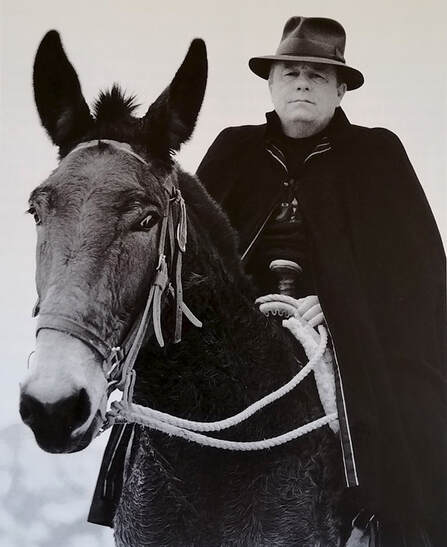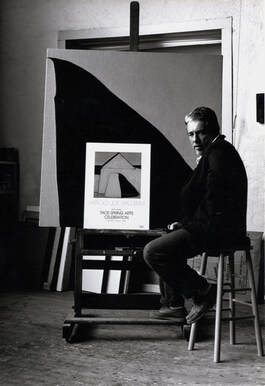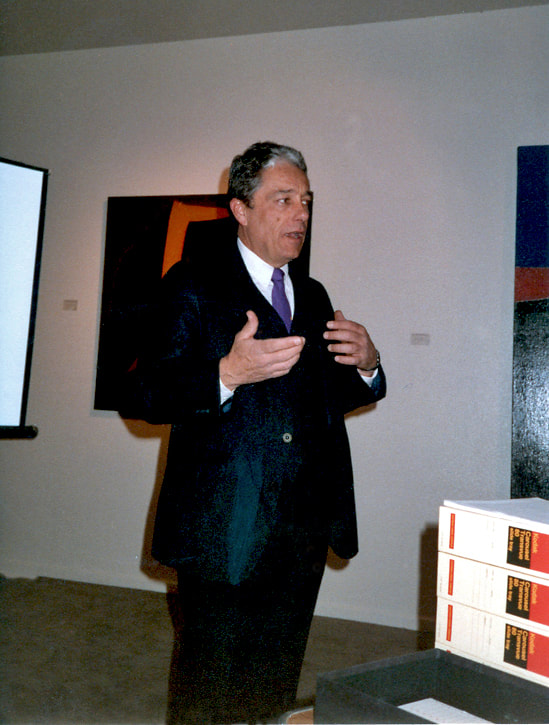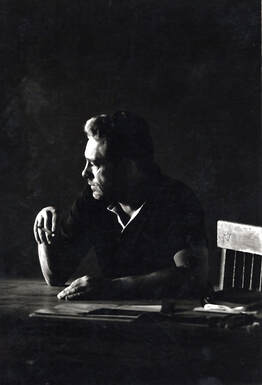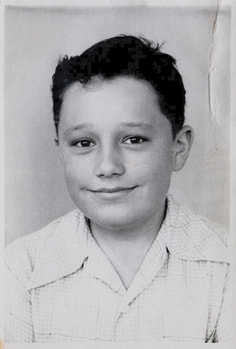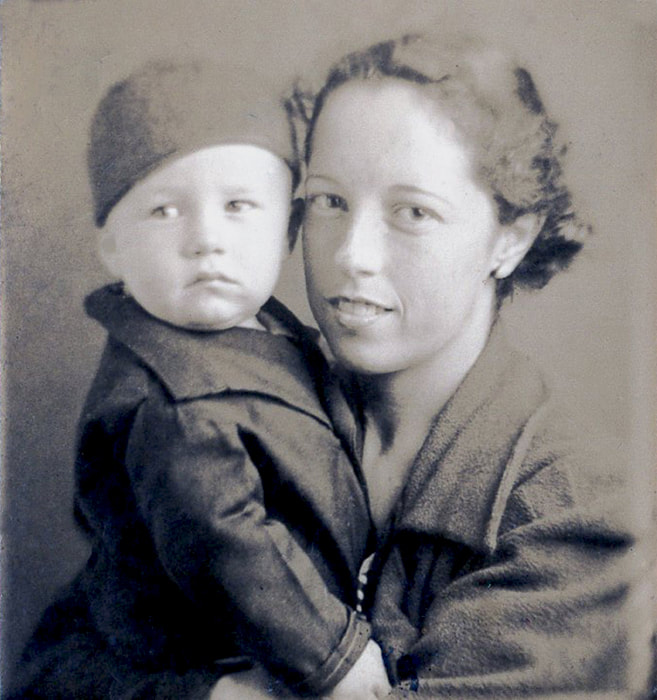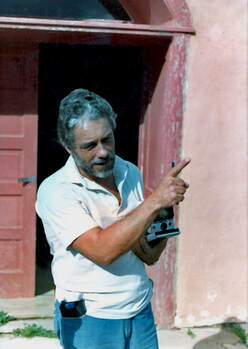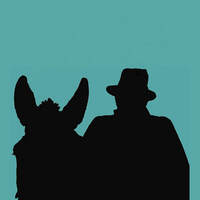A Biographical Chronology
of Harold Joe Waldrum
1934–2003
By Susan A. Christie
of Harold Joe Waldrum
1934–2003
By Susan A. Christie
"Ando en Cueros is based on my belief that the art world has fallen in with bad company and lurched awry. Herein are some of my thoughts: some are old, some are fresh, some are intransigent, some are faltering as I turn sixty and wiser." ––Ando en cueros (I Walk Stark-naked), Harold Joe Waldrum, 1994
As a self-described “romantic-formalist,” Harold Joe Waldrum was the type of larger-than-life character that New Mexico delights in embracing. Words for such a talent are many: brilliant, driven, haunted, opinionated, flamboyant, soft-hearted. Among Waldrum's distinctive characteristics was his insistence on painting in the nude, taking breaks to conduct, with his baton, recordings of Bach or Mahler or Poulenc.
Waldrum's journey began on August 23, 1934, in Savoy, Texas, northeast of Dallas. By the time of his death in 2003, he had become an inveterate storyteller with an extraordinary memory
for detail.
In the Introduction to Waldrum's autobiography Ando en cueros (I Walk Stark-naked), he recounts an experience with a Santa Fe gallery director who edited out a particularly interesting point the gallery's writer had made about Waldrum. Disappointed, H. Joe observed, all that was left was the "usual stuff you read about artists: where they went to school ….” He believed "that interesting information is more important” than trite “art-speak.” This writer apologizes posthumously to H. Joe, whom I never met, as I do include the "usual" but necessary information for the readers of this piece to more fully understand and appreciate the man.
Waldrum's first and lifelong muse was music. Attending Western State College (Gunnison, Colorado), he graduated in 1956 with a bachelor of science degree in music. Painting in his spare time, he was a band teacher and music arranger for 16 years and an art teacher for 14 in Lakin, Kansas. In 1960 he returned to college in Hays, Kansas, graduating summa cum laude in 1970 with a master of fine arts from Fort Hays State College.
That year Waldrum’s paintings were described by his contemporaries as Abstract Expressionism. However in 1971, after some thought, H. Joe denied that label, choosing instead to nominate himself "artist" (an Otto Rank concept).
Waldrum’s epiphany and subsequent mission was to overcome his college education. With the realization that his previous artwork was really an imitation of other artists, he stopped painting and drawing for three months. An internal voice “pestering” him said, “You are using other people’s ordinary.” Shocked by this revelation he "stood, stark-naked in the middle of my life and I knew I couldn't go back".
He moved first to Texas hill country, painting in a friend’s barn in Kerrville, then to Tesuque, New Mexico, just outside of Santa Fe. Waldrum was now determined to find his own distinct creative voice. The culture, landscape, and spectacular light and shadows of New Mexico became the focus for his developing vision. He subsequently moved from the Santa Fe area to Taos, where he lived in Llano Quemado.
The ‘70s in New Mexico continued a golden age for artists and the galleries who represented their artworks. This Southwest story begins with artists Bert Greer Phillips and Ernest L. Blumenschein in September of 1898. The artists were on a painting trip from New York to Mexico when they broke a wagon wheel outside of Taos and stayed on for repairs. Impressed by the landscape and the culture they decided to remain and paint. As early as 1915 an artist colony emerged with the formation of the Taos Society of Artists by six artists who are referred to as "the Founders." As its fame spread, many artists came from all over the world to spend time in New Mexico which has continued to be an artist mecca.
The "window series" was the first to appear from Waldrum's new direction. Spending nearly a decade on this series, which was based on the “tripartite” forms and thematic implications of windows set in adobe walls, Waldrum made studies of color, weight and value.
In 1974, H. Joe moved to Gusano, a tiny village near Pecos, New Mexico. Two years later a tragic event changed his life. He shot and killed a man in a gunfight when a group of criminals broke into his studio. Waldrum fled in his bullet-riddled van. He returned the next day with back-up, only to find his studio––which contained all his paintings, drawings and musical scores––burned to the ground. He wrote 1994: "Things have never been the same since the gunfight in 1976. The gunfight was and remains today, the most significant and life-altering event of my
60 years."
Three months later, escaping from the relatives of the deceased, Waldrum went to New York City. For several years he spent winters in New York and summers in and around Taos.
Waldrum's encounter with Polaroid cameras occurred in the late ‘70s when he was returning to New York after a summer in Taos. The SX-70 camera, with its accompanying Time Zero film, enabled him to take images of the San Jose de Garcia Church at Las Trampas while working during the winter. The camera would become an integral part of his work, as he subsequently went on to take thousands of photographs.
Waldrum finally returned to Taos in the early 1980s, setting up residence in the studio built in 1915 by famous Taos painter Joseph Henry Sharp (secured for him by his long-time friend and advisor John Freeman Norton). During these years Waldrum produced a wealth of paintings, drawings, polaroids and videographs.
Now began Waldrum's most prolific years during which he painted his best known work: the adobe churches and “penitent moradas” of Northern New Mexico. Waldrum went so far as to establish the El Valle Foundation in 1985 and began working to preserve the buildings that had inspired many of his paintings. Some churches were saved through the efforts of this foundation, however the church at El Valle was demolished. In partnership with Jim Heese, he produced a videotape, documenting the failed efforts to preserve this historical building. They also created a series of videos documenting other churches, in Las Trampas and Picuris Pueblo, which were aired in local television channels.
According to art historian Mary Anne Redding, Waldrum had “campaigned tirelessly to let people know how significant these structures were and why it was important to preserve them, not just as spiritual centers for isolated communities, but also to maintain the history and culture of Spanish New Mexico.”His efforts were not all in vain; they did succeed in preserving a few of the churches in part due to their efforts. Waldrum and Heese also produced videos showing artists at work, including Waldrum, Larry Bell, Alyce Frank, and Melissa Zink.
His successful collaboration, in the 1980's, with Robert Blanchard of the Custom Etching Studio in Albuquerque translated his paintings into two major graphic mediums, aquatint etchings and linocuts.
Waldrum moved to his best-loved location, “Mountain Ranch,” around 1990. La Sierra de Los Ladrones was an isolated ranch near Bernardo, New Mexico. During this time, he produced some of his finest work. "Under the gaze of the Sierra Ladrones,” he lived off the grid, painted and raised mules (June Bug, Mayday, Miss Daisy, and Moon). Between sessions in his studio Waldrum wrote his self-published autobiography (Ando en cueros: I Walk Stark-naked). This book combines discerning essays with photos of his ranch, livestock and ranch cowboys illuminated by 64 color reproductions of his work.
Waldrum's final move was to Truth or Consequences, New Mexico, around 1997 where he worked out of a studio on Main Street before founding the RioBravoFineArt® Gallery in a
former, several story, hardware store. Before his death, he often traveled to Albuquerque to work with the printmaker Michael Costello, as Blanchard had retired.
Harold Joe Waldrum died in Truth or Consequences on December 13, 2003. More than 100 people attended his memorial in Columbus, NM, which was held December 19, 2003.
His Epitaph? Perhaps unknowingly at the time, H. Joe said it best: "There are so many people to thank; but I should also mention that there are three of you out there who can go to hell.”
Addendum:
In January 2010, The Albuquerque Museum opened "A Passionate Life,” an exhibition of selected images from nearly 8,000 SX-70 Polaroid photographs taken by Harold Joe Waldrum who called these works his "little jewels." The collection was donated to the Museum by the Waldrum Estate and Rio Bravo Fine Art Gallery in Truth or Consequences.
A collection of Harold Joe Waldrum’s linocuts and aquatint etchings are included in the permanent collection of The Palm Springs Museum, Palm Springs, CA. Donated by Waldrum, this gift contains all working drawings, separation proofs, progression proofs and final impressions made by Waldrum from December 1983.
A collection of 12 Harold Joe Waldrum's Aquatint Etchings are in the permanent collection of the Tucson Museum of Art and Art Block.
His works are also held in the collections of the Museum of New Mexico, the Albuquerque Museum of Art and History, and the Harwood Foundation of Taos, New Mexico.
Definitions:
Aquatint is an intaglio printmaking technique, a variant of etching.
In intaglio printmaking, the artist makes marks on the plate (in the case of aquatint, a copper or zinc plate) that are capable of holding ink. The inked plate is passed through a printing press together with a sheet of paper, resulting in a transfer of the ink to the paper. This can be repeated a number of times, depending on the particular technique.
Linocut is a printmaking technique, a variant of woodcut in which a sheet of linoleum (sometimes mounted on a wooden block) is used for a relief surface. A design is cut into the linoleum surface with a sharp knife, V-shaped chisel or gouge, with the raised (uncarved) areas representing a reversal (mirror image) of the parts to show printed. The linoleum sheet is inked with a brayer, and then impressed onto paper using a printing press.
Sources:
Eduardo Alicea, Owner/Director, RioBravoFineArt, Truth or Consequences, NM, 2012.
Olin B. West, Artist, Truth or Consequences, NM, 2012.
Various
© 2012 written by Susan A. Christie. Published 2012 by RioBravoFineArt, Eduardo Alicea, Director, Truth or Consequences, New Mexico. Updated 2018-2019
Waldrum's journey began on August 23, 1934, in Savoy, Texas, northeast of Dallas. By the time of his death in 2003, he had become an inveterate storyteller with an extraordinary memory
for detail.
In the Introduction to Waldrum's autobiography Ando en cueros (I Walk Stark-naked), he recounts an experience with a Santa Fe gallery director who edited out a particularly interesting point the gallery's writer had made about Waldrum. Disappointed, H. Joe observed, all that was left was the "usual stuff you read about artists: where they went to school ….” He believed "that interesting information is more important” than trite “art-speak.” This writer apologizes posthumously to H. Joe, whom I never met, as I do include the "usual" but necessary information for the readers of this piece to more fully understand and appreciate the man.
Waldrum's first and lifelong muse was music. Attending Western State College (Gunnison, Colorado), he graduated in 1956 with a bachelor of science degree in music. Painting in his spare time, he was a band teacher and music arranger for 16 years and an art teacher for 14 in Lakin, Kansas. In 1960 he returned to college in Hays, Kansas, graduating summa cum laude in 1970 with a master of fine arts from Fort Hays State College.
That year Waldrum’s paintings were described by his contemporaries as Abstract Expressionism. However in 1971, after some thought, H. Joe denied that label, choosing instead to nominate himself "artist" (an Otto Rank concept).
Waldrum’s epiphany and subsequent mission was to overcome his college education. With the realization that his previous artwork was really an imitation of other artists, he stopped painting and drawing for three months. An internal voice “pestering” him said, “You are using other people’s ordinary.” Shocked by this revelation he "stood, stark-naked in the middle of my life and I knew I couldn't go back".
He moved first to Texas hill country, painting in a friend’s barn in Kerrville, then to Tesuque, New Mexico, just outside of Santa Fe. Waldrum was now determined to find his own distinct creative voice. The culture, landscape, and spectacular light and shadows of New Mexico became the focus for his developing vision. He subsequently moved from the Santa Fe area to Taos, where he lived in Llano Quemado.
The ‘70s in New Mexico continued a golden age for artists and the galleries who represented their artworks. This Southwest story begins with artists Bert Greer Phillips and Ernest L. Blumenschein in September of 1898. The artists were on a painting trip from New York to Mexico when they broke a wagon wheel outside of Taos and stayed on for repairs. Impressed by the landscape and the culture they decided to remain and paint. As early as 1915 an artist colony emerged with the formation of the Taos Society of Artists by six artists who are referred to as "the Founders." As its fame spread, many artists came from all over the world to spend time in New Mexico which has continued to be an artist mecca.
The "window series" was the first to appear from Waldrum's new direction. Spending nearly a decade on this series, which was based on the “tripartite” forms and thematic implications of windows set in adobe walls, Waldrum made studies of color, weight and value.
In 1974, H. Joe moved to Gusano, a tiny village near Pecos, New Mexico. Two years later a tragic event changed his life. He shot and killed a man in a gunfight when a group of criminals broke into his studio. Waldrum fled in his bullet-riddled van. He returned the next day with back-up, only to find his studio––which contained all his paintings, drawings and musical scores––burned to the ground. He wrote 1994: "Things have never been the same since the gunfight in 1976. The gunfight was and remains today, the most significant and life-altering event of my
60 years."
Three months later, escaping from the relatives of the deceased, Waldrum went to New York City. For several years he spent winters in New York and summers in and around Taos.
Waldrum's encounter with Polaroid cameras occurred in the late ‘70s when he was returning to New York after a summer in Taos. The SX-70 camera, with its accompanying Time Zero film, enabled him to take images of the San Jose de Garcia Church at Las Trampas while working during the winter. The camera would become an integral part of his work, as he subsequently went on to take thousands of photographs.
Waldrum finally returned to Taos in the early 1980s, setting up residence in the studio built in 1915 by famous Taos painter Joseph Henry Sharp (secured for him by his long-time friend and advisor John Freeman Norton). During these years Waldrum produced a wealth of paintings, drawings, polaroids and videographs.
Now began Waldrum's most prolific years during which he painted his best known work: the adobe churches and “penitent moradas” of Northern New Mexico. Waldrum went so far as to establish the El Valle Foundation in 1985 and began working to preserve the buildings that had inspired many of his paintings. Some churches were saved through the efforts of this foundation, however the church at El Valle was demolished. In partnership with Jim Heese, he produced a videotape, documenting the failed efforts to preserve this historical building. They also created a series of videos documenting other churches, in Las Trampas and Picuris Pueblo, which were aired in local television channels.
According to art historian Mary Anne Redding, Waldrum had “campaigned tirelessly to let people know how significant these structures were and why it was important to preserve them, not just as spiritual centers for isolated communities, but also to maintain the history and culture of Spanish New Mexico.”His efforts were not all in vain; they did succeed in preserving a few of the churches in part due to their efforts. Waldrum and Heese also produced videos showing artists at work, including Waldrum, Larry Bell, Alyce Frank, and Melissa Zink.
His successful collaboration, in the 1980's, with Robert Blanchard of the Custom Etching Studio in Albuquerque translated his paintings into two major graphic mediums, aquatint etchings and linocuts.
Waldrum moved to his best-loved location, “Mountain Ranch,” around 1990. La Sierra de Los Ladrones was an isolated ranch near Bernardo, New Mexico. During this time, he produced some of his finest work. "Under the gaze of the Sierra Ladrones,” he lived off the grid, painted and raised mules (June Bug, Mayday, Miss Daisy, and Moon). Between sessions in his studio Waldrum wrote his self-published autobiography (Ando en cueros: I Walk Stark-naked). This book combines discerning essays with photos of his ranch, livestock and ranch cowboys illuminated by 64 color reproductions of his work.
Waldrum's final move was to Truth or Consequences, New Mexico, around 1997 where he worked out of a studio on Main Street before founding the RioBravoFineArt® Gallery in a
former, several story, hardware store. Before his death, he often traveled to Albuquerque to work with the printmaker Michael Costello, as Blanchard had retired.
Harold Joe Waldrum died in Truth or Consequences on December 13, 2003. More than 100 people attended his memorial in Columbus, NM, which was held December 19, 2003.
His Epitaph? Perhaps unknowingly at the time, H. Joe said it best: "There are so many people to thank; but I should also mention that there are three of you out there who can go to hell.”
Addendum:
In January 2010, The Albuquerque Museum opened "A Passionate Life,” an exhibition of selected images from nearly 8,000 SX-70 Polaroid photographs taken by Harold Joe Waldrum who called these works his "little jewels." The collection was donated to the Museum by the Waldrum Estate and Rio Bravo Fine Art Gallery in Truth or Consequences.
A collection of Harold Joe Waldrum’s linocuts and aquatint etchings are included in the permanent collection of The Palm Springs Museum, Palm Springs, CA. Donated by Waldrum, this gift contains all working drawings, separation proofs, progression proofs and final impressions made by Waldrum from December 1983.
A collection of 12 Harold Joe Waldrum's Aquatint Etchings are in the permanent collection of the Tucson Museum of Art and Art Block.
His works are also held in the collections of the Museum of New Mexico, the Albuquerque Museum of Art and History, and the Harwood Foundation of Taos, New Mexico.
Definitions:
Aquatint is an intaglio printmaking technique, a variant of etching.
In intaglio printmaking, the artist makes marks on the plate (in the case of aquatint, a copper or zinc plate) that are capable of holding ink. The inked plate is passed through a printing press together with a sheet of paper, resulting in a transfer of the ink to the paper. This can be repeated a number of times, depending on the particular technique.
Linocut is a printmaking technique, a variant of woodcut in which a sheet of linoleum (sometimes mounted on a wooden block) is used for a relief surface. A design is cut into the linoleum surface with a sharp knife, V-shaped chisel or gouge, with the raised (uncarved) areas representing a reversal (mirror image) of the parts to show printed. The linoleum sheet is inked with a brayer, and then impressed onto paper using a printing press.
Sources:
- Ando en cueros (I Walk Stark-naked), Harold Joe Waldrum, 1994
- "Harold Joe Waldrum," William Peterson Artspace, Southwestern Contemporary Arts Quarterly, Winter 1981–82
- "Harold Joe Waldrum: Searching for the Ordinary", ARTlines Archives, Interview, 1982.
- "Harold Joe Waldrum at Tally Richards, Taos," William Peterson Artspace, Southwestern Contemporary Arts Quarterly, Winter 1984–85
- "H. Joe Waldrum, An Artist teetering on the brink,” by Mary Stephenson. Reprinted from The Taos News, October 27, 1994.
- Obituary, Harold Joe Waldrum, Reprinted with permission of the Albuquerque Journal; Artist Joe Waldrum Painted Church Scenes By Paul Logan, Journal Staff Writer. 2003
- Santa Fe Bohemia: The Art Colony, 1964–1980, Eli Levin, Sunstone Press, December 31, 2006.
- Redding, Mary Anne (Spring 2011). "A Passionate Light: The Polaroids of H. Joe Waldrum". El Palacio. pp. 54–57.
- Scherch, Meg (1987-02-05). "Taos art stars now becoming video stars on local TV". The Taos News.
Eduardo Alicea, Owner/Director, RioBravoFineArt, Truth or Consequences, NM, 2012.
Olin B. West, Artist, Truth or Consequences, NM, 2012.
Various
© 2012 written by Susan A. Christie. Published 2012 by RioBravoFineArt, Eduardo Alicea, Director, Truth or Consequences, New Mexico. Updated 2018-2019
*******

